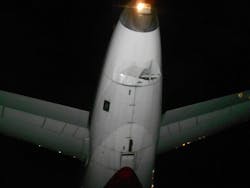Jan. 05--It was barely a bump. But it demonstrated a critical safety problem: airliners, loaded with people and fuel, occasionally collide with other planes, service trucks, baggage carts and jet bridges while on the ground.
In the latest incident, a Spirit jetliner's wingtip accidentally clipped the tail of a parked U.S. Airways plane in Fort Lauderdale on New Year's Eve, causing minor damage to both aircraft. Few of the 167 passengers on Spirit Flight 403 even felt the contact.
Yet the National Transportation Safety Board wants to know exactly what happened because of the potential for disaster, if, for instance, the collision had been considerably harder. The NTSB has included such airliner fender-benders on its most-wanted list of safety improvements.
"While commercial aviation has made extraordinary strides in safety, one area where risk remains is on the airport surface," said Eric Weiss, NTSB spokesman. "The bottom line is planes should not run into each other in the air or on the ground."
Although most ground accidents are minor, the NTSB lumps them with more major mishaps, such as planes accidentally taxiing onto an active runway or using a wrong runway. All involve ground operations, and several ground accidents have been deadly, including aviation's worst disaster: in March 1977, a KLM 747 collided with a Pan Am 747 on a fog-shrouded runway in the Canary Islands, killing 583 people.
While planes or vehicles mistakenly drove onto runways more than 1,100 times in 2012, the number of airline fender-benders is small, only about 15 per year. The infractions are frequently the result of distraction or overload on the part of pilots, air traffic controllers and other airport workers, aviation experts say.
"It's a human issue," said Mike Nonnemacher, operations director for Fort Lauderdale-Hollywood International Airport. "It could range from someone who gets complacent to someone who's inexperienced to someone who doesn't follow procedure."
Nonnemacher said that in his 26 years at Fort Lauderdale, he has never seen a serious collision between two aircraft on the ground. Yet in July 2007, two jetliners came within 100 feet of colliding at that airport: a United Airbus A320 errantly taxied onto a runway just as a Delta Boeing 757 was touching down. A controller yelled at the Delta plane to immediately climb back into the air, averting disaster. A combined 307 people were on the two planes.
Even when a jetliner suffers a tiny ding, repairs can cost an airline tens of thousands of dollars. Planes are usually pulled from service to be inspected for hidden damage, and passengers placed on other flights.
South Florida's three major airports combined see fewer than one ground accident per year on average. Before the Spirit vs. U.S. Airways mishap, the most recent was in 2005, according to Federal Aviation Administration records.
At Palm Beach International Airport, a Delta 767's wing struck a parked aircraft in 1993; in 1989, the engine of a Presidential Airways regional jet rammed a jet bridge.
At Fort Lauderdale-Hollywood International, a DC-9 wingtip struck a food truck in 1995, and a Convair 440 collided with the corner of a terminal building in 1987.
At Miami International, the wing of a Miami Air 737 struck a catering truck in July 2005. A VASP Brazilian Airlines MD-11 struck a parked Alitalia 747, rocking a combined 601 passengers in 1996; no one was injured.
Outside of South Florida, there have been some relatively minor accidents that came close to becoming full-blown catastrophes.
In April 2011, as it taxied to a runway, the wing of a superjumbo Air France A380 wing clipped the tail of a stopped Delta regional jet at New York's John F. Kennedy International Airport. The smaller plane, holding 62 passengers and four crew members, was spun around 90 degrees. No one was hurt.
In November 2010, a driver got out of a service truck and left the engine running at Chicago O'Hare International Airport. The empty truck slipped into reverse and backed into a taxiing Skywest regional jet with 37 people on board. No one was hurt.
In the Dec. 31 incident, the Spirit plane had just landed and was headed toward its gate, using a taxi lane near a remote aircraft parking area. When planes are parked in that area, the airport puts up barricades and red lights to warn other aircraft to steer clear. But no one told airport officials the U.S. Airways plane would be parked there.
The Broward County Aviation Department is investigating why it wasn't notified. As for the Spirit plane, Nonnemacher said, "The pilot was doing what the pilot was supposed to do."
[email protected] or 954-572-2085.
Copyright 2013 - Sun Sentinel

